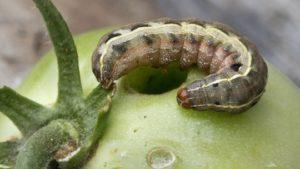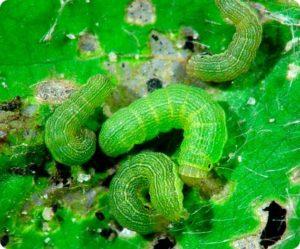Fighting the armyworm on tomatoes: a guide to protecting tomatoes from pests
One of the well-known types of scoops can be called a tomato. The second name of the pest is Karandrina. This variety destroys one of the most beloved vegetables - the tomato.
Content
What does a tomato scoop look like: photo
Description of the tomato scoop
Name: Tomato scoop or carandrina
Latin:Laphygma exiguaClass: Insects - Insecta
Squad: Lepidoptera - Lepidoptera
Family: Owls - Noctuidae
 | Habitats: | all over the world |
 | Dangerous for: | polyphagous pest, more than 30 plant species |
 | Means of destruction: | folk, chemical and biological preparations |
Wingspan up to 2,4 mm. The forewings are gray-brown with transverse double smooth lines. There are 2 spots on the wings. The brownish spot is kidney-shaped. A round speck of a rusty-orange hue. Hind wings are white. They have a light pink coating.
The eggs are yellow-green. Diameter 0,5 mm. Larva in length from 2,5 cm to 3 cm. The color can be either green or brown. On each side there is a wide dark stripe, under it yellowish stripes. The abdomen is lighter with white spots. The pupa is yellowish-brown. In length up to 14 mm.
Life cycle
The flight of butterflies falls on May - the end of October. After 1 - 3 days after departure, females lay eggs. Over the entire life cycle, it can lay up to 1700 eggs. The butterfly of the first generation is the most prolific.
The clutch of eggs consists of three to four piles, each of which contains 250 eggs. Places of masonry - the underside of the leaves of weeds. Shelter is grayish hairs that the female sheds from the abdomen.
Egg development takes from 2 to 10 days. This period is affected by temperature. Caterpillars develop from 2 to 4 weeks. Young individuals feed on weeds, older ones on cultivated plants. They make holes in the leaves and leave veins.
The caterpillar pupates in the ground. The depth is usually from 3 to 5 cm. The pupa is formed from one to four weeks.
Habitat
Karandrina inhabits a huge area, distributed almost throughout the temperate and subtropical climate. Most often, the scoop on tomatoes inhabits:
- the European part of the Russian Federation;
- Southern Siberia;
- the Urals;
- Far East;
- the Baltic;
- Belarus;
- Ukraine;
- Moldova;
- Kazakhstan;
- Central Asia;
- China;
- Southern Europe;
- Africa;
- Australia;
- America.
Economic importance
The insect is classified as a polyphagous pest. The diet of the tomato scoop consists of cotton, alfalfa, sugar beets, corn, tobacco, peanuts, sesame, soybeans, tomatoes, potatoes, peas, turnips, eggplant, watermelon, clover, citrus fruits, apple trees, quince, grapes, acacia, chrysanthemum, oak.
Caterpillars are engaged in eating buds, buds, flowers, young leaves. They prefer legumes, bluegrass, nightshade, mallow, haze.
preventive measures
Compliance with simple rules will help to avoid the invasion of pests. For this you need:
- regularly inspect the leaves and stems;
- remove weeds;
- digging up the soil in autumn and spring - contributes to the destruction of pupae;
- plant calendula, basil, cilantro - they do not tolerate the smell;
- remove plants and fruits that have damaged the caterpillars.
Ways to deal with scoops on tomatoes
There are several ways that allow you to cope with the pest. They are represented by chemicals, biological methods or folk remedies.
Chemical and biological methods
When a large number of caterpillars appear, Lepidocid, Agravertin, Aktofit, Fitoverm are used. All drugs belong to the 4th hazard class. Biological compounds are quickly withdrawn.
Of chemicals prefer "Inta-Vir", "Decis", "Avant". The withdrawal period of pesticides is at least a month.
Among the shortcomings, it can be noted that chemicals are absorbed into the ground and tomatoes. Calculate in advance the expected start of the harvest.
Folk ways
Among the large number of methods of struggle taken from the experience of the people, there are several of the most effective.
It is desirable to add laundry soap to any solution. The soap makes the mixture sticky and sticks to the plants.
To choose a reliable method of protection, it is better to familiarize yourself with 6 ways to deal with owls.
Scoop varieties that feed on tomatoes
In addition to the tomato scoop, tomatoes are a diet for:
- potato;
- cabbage;
- cotton variety.
It is recommended to plant tomatoes away from cabbage and potatoes. However, when these types of cutworms appear, the same biological and chemical preparations are used.
Conclusion
The fight against tomato scoop must begin at the first sign of the appearance of pests. Timely prevention and treatment will help keep the plants whole.
Previous
